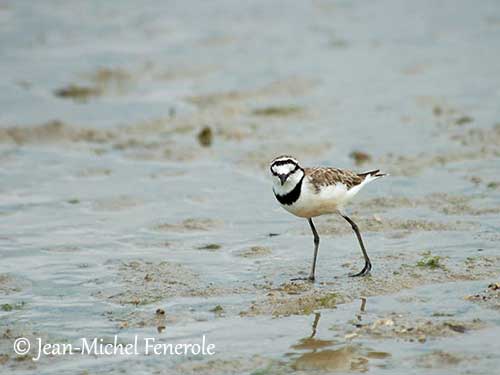
Fr: Gravelot à bandeau noir
Ang: Madagascan Plover - Black-banded Plover
All: Madagaskarregenpfeifer
Esp: Chorlitejo torácico
Ita: Corriere del Madagascar
Nd: Madagaskarplevier
Sd: madagaskarpipare
Photographers:
John Anderson
John Anderson Photo Galleries
Jean Michel Fenerole
Photos d’Oiseaux du monde
William Price
PBase-tereksandpiper & Flickr William Price
Dubi Shapiro
Dubi Shapiro Photo Galleries & Dubi Shapiro's Pictures on IBC
Alan & Ann Tate
AA Bird Photography
Text by Nicole Bouglouan
Sources:
HANDBOOK OF THE BIRDS OF THE WORLD Vol 3 by Josep del Hoyo-Andrew Elliott-Jordi Sargatal - Lynx Edicions - ISBN: 8487334202
Waterbirds Around the World: A Global Overview of the Conservation, Management and Research of the World's Waterbird Flyways by G. C. Boere, Colin A. Galbraith, David A. Stroud – Editeur: The Stationery Office, 2006 – ISBN: 0114973334, 9780114973339
The Birds of Africa: Volume VIII: The Malagasy Region: Madagascar, Seychelles, Comoros, Mascarenes - Par Roger Safford, Frank Hawkins – ISBN: 1408190494, 9781408190494- Editeur: A&C Black, 2013
Birds of Madagascar and the Indian Ocean Islands Par Roger Safford, Adrian Skerrett, Frank Hawkins – ISBN: 1472924118, 9781472924117- Editeur: Bloomsbury Publishing, 2015
Birds of Madagascar: A Photographic Guide Par Pete Morris, Frank Hawkins – ISBN: 0300077556, 9780300077551- Editeur: Yale University Press, 1998
SHOREBIRDS by Peter Hayman, John Marchant and Tony Prater – Christopher Helm – 1986 – ISBN: 0747014035
Wikipedia, the free encyclopaedia
Breeding distribution and ecology of the threatened Madagascar Plover Charadrius thoracicus
Madagascan Plover
Charadrius thoracicus
Charadriiformes Order – Charadriidae Family
INTRODUCTION:
The Madagascan Plover is endemic to Madagascar where it occurs along W and S coasts in dry grazed grassland. It is rarely found inland. It feeds on insects, spiders, worms and molluscs and is often seen in flocks with other plovers outside breeding season. It breeds in open grasslands and dry mudflats adjacent to lakes and mangroves. It is very territorial during the breeding season, but it becomes more gregarious outside this period. It is faithful to its breeding sites.
The Madagascan Plover is threatened by modifications of its wetland habitats and trampling by grazing cattle during the nesting period. The species is currently listed as Vulnerable.

DESCRIPTION OF THE BIRD:
Biometrics:
Length: 13-14 cm
Weight: M: 32-42 g – F: 31-43 g
The Madagascan Plover in breeding plumage has dark brown upperparts narrowly fringed pale buff. In flight, we can see a narrow, white wingbar, and the white sides of rump and tail. The flight feathers are blackish.
The underparts are yellowish-orange with darkest central belly. Lower belly and undertail-coverts are white. There is a conspicuous black breastband contiguous with black hindneck collar and eye stripe. The underwing-coverts are white.
On the head, the crown is dark brown, surrounded by white stripe and then a black band extending from forecrown, through eyes and ear-coverts and to the hindneck. Forehead, cheeks, chin and throat are white. Lores are black.
The bill is black. The eyes are dark brown. Legs and feet are dark grey to blackish.
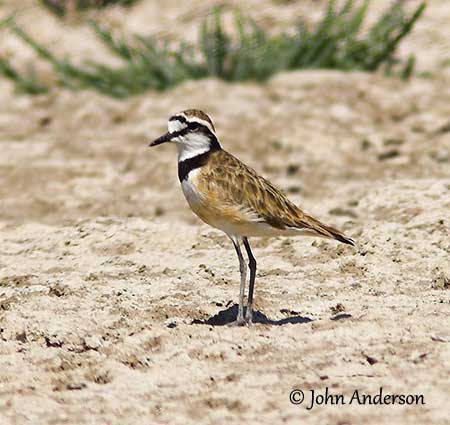
The female resembles males but she has slightly paler underparts. However, she is heavier with longer wings, but she has shorter tarsi.
The non-breeding adult is duller overall, with much of black replaced by brown.
The juvenile shows dull brown and pale buff head pattern (not black-and-white). The underparts are mostly greyish-white with distinct greyish-brown breast band. Legs and feet are grey.
RANGE:
The Madagascan Plover is restricted to W and S coasts, rarely more than 6 km inland. It usually occurs between Boanamary “Mahajanga” in NW, and Tapera “Tolagnaro” in SE. it is occasionally reported from the E coast.
HABITAT:
The Madagascan Plover frequents and breeds in short coastal grassland and edges of brackish pools, intertidal mudflats (wet and dry), salt marshes, lakes and mangroves. It also frequents the shrimp farms in the Baly Bay and Besalampy area.
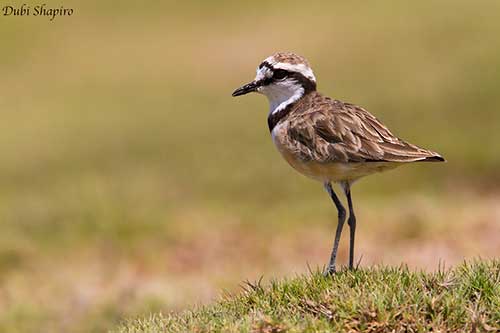
CALLS AND SONGS: SOUNDS BY XENO-CANTO
The Madagascan Plover gives typical, short ‘pit” or “tsewit”. During the distraction displays, the adults give “pi-pi-pi” calls.
Several various calls are uttered during the breeding season, when they join group, in flight, in alarm and when attending the chicks.
BEHAVIOUR IN THE WILD:
The Madagascan Plover feeds on various invertebrates such as insects, spiders, worms and molluscs.
It is commonly seen with other coastal plovers outside breeding period. They forage in dry or wet grassland and mudflats around lakes, and mainly by day.
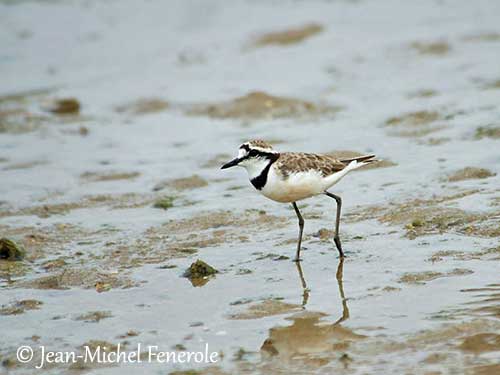
The Madagascan Plover is highly territorial during the breeding season and lives strictly in pairs. During this period, they forage within or a short distance outside the territory where they may be active at night. They roost on the ground, especially in the middle of the day.
The species is monogamous, and site-fidelity is usually reported. Both nest and territory are defended by mates against other plovers.
During the displays, both in courtship and territorial defence, the bird runs with the head held towards the opponent in order to chase it away with short runs, halts, flights and fighting accompanied by loud “triiiiiiiiiii” and “kooooooo” calls. Neck and forehead feathers are sometimes erect during the chases.
Both parents build the nest and share all the nesting duties.
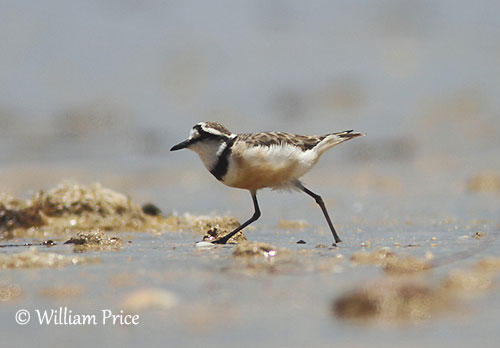
The Madagascan Plover is resident and sedentary on the island.
The species has more rounded wings than other Charadrius plovers, and only performs short-distance flights.
REPRODUCTION OF THIS SPECIES:
The breeding season occurs between August and May, with peak in December/April, with some geographical variations.
The Madagascan Plover nests in open grassland and dry mudflats around mangroves and lakes. Both adults build the nest, a small scrape in dry ground with a lining of pieces of dry and fresh vegetation and some stones or broken shells. The nests are more than 400 metres apart. The scrape is often close to water, but it may be flooded in tidal areas.
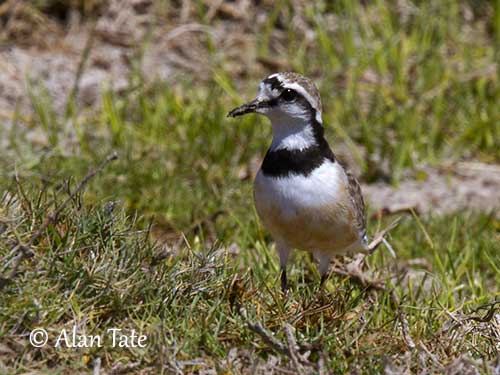
The female lays 1-2 cryptic eggs, dark grey-brown with darker markings. Both adults share the incubation during 26-28 days. Eggs and nest are defended against predators and other plovers. The eggs are covered with earth or vegetation when unattended.
At hatching, the chicks are brooded by their parents. They are able to feed themselves, and the adults lead them to the feeding sites within the territory. They usually fly 28-30 days after hatching. They may remain in family group during 2-3 months after fledging. They acquire the adult plumage at one year of age.
The breeding success is usually low, caused by nest failure due to predation and flooding.
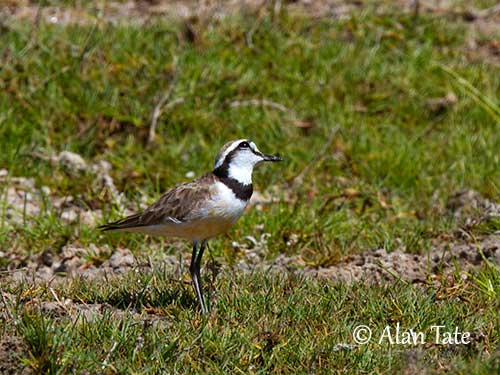
PROTECTION / THREATS / STATUS:
The Madagascan Plover has small population threatened by degradation of wetland habitats, egg-collection locally, trampling by grazing cattle, predation by Pied Crow and Black Kite, feral cats and stray dogs, and Grandidier’s Mongoose (Galidictis grandidieri).
The population is roughly estimated to number 2,700/3,500 individuals, and suspected to be declining due to habitat loss and degradation.
The Madagascan Plover is currently listed as Vulnerable.
